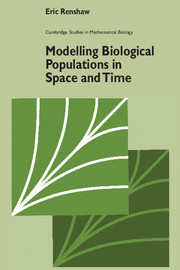Book contents
- Frontmatter
- Contents
- Dedication
- Preface
- A list of symbols and notation
- 1 Introductory remarks
- 2 Simple birth–death processes
- 3 General birth–death processes
- 4 Time-lag models of population growth
- 5 Competition processes
- 6 Predator–prey processes
- 7 Spatial predator–prey systems
- 8 Fluctuating environments
- 9 Spatial population dynamics
- 10 Epidemic processes
- 11 Linear and branching architectures
- References
- Author index
- Subject index
11 - Linear and branching architectures
Published online by Cambridge University Press: 05 August 2012
- Frontmatter
- Contents
- Dedication
- Preface
- A list of symbols and notation
- 1 Introductory remarks
- 2 Simple birth–death processes
- 3 General birth–death processes
- 4 Time-lag models of population growth
- 5 Competition processes
- 6 Predator–prey processes
- 7 Spatial predator–prey systems
- 8 Fluctuating environments
- 9 Spatial population dynamics
- 10 Epidemic processes
- 11 Linear and branching architectures
- References
- Author index
- Subject index
Summary
A whole new approach is needed if we are to consider the complete route taken by all members of a developing population. For example, we may wish to study the space–time development of an invading species of ant as it reproduces and spreads across a region. The resulting map will resemble a ‘tree’, with current ant positions corresponding to branch buds, births to branch forks, deaths to branch ends, and the paths between such events to the branches themselves. Though such scenarios are not often encountered in population dynamics, tree-like structures abound in biology, and a way of describing and analyzing them is clearly needed. Obvious examples include lung-airways, neural and arterial networks, and plant rhizome systems; examples of more abstract networks include the concepts of food webs and dominance relations in animal society. MacDonald (1983) provides an excellent overview of this potentially vast subject area. His presentation is eminently readable by mathematician and biologist alike, and provides an ideal starting point for readers wishing to pursue this highly absorbing subject.
In order to find our way around a tree or network (the former implies the absence of closed paths, the latter does not) we need to define an ordering over the connected branches. Fortunately, geographers spent considerable effort in the 1950s and 1960s investigating various possibilities for stream and river networks, and this work has been of considerable benefit to subsequent biological research.
- Type
- Chapter
- Information
- Modelling Biological Populations in Space and Time , pp. 360 - 384Publisher: Cambridge University PressPrint publication year: 1991
- 1
- Cited by

